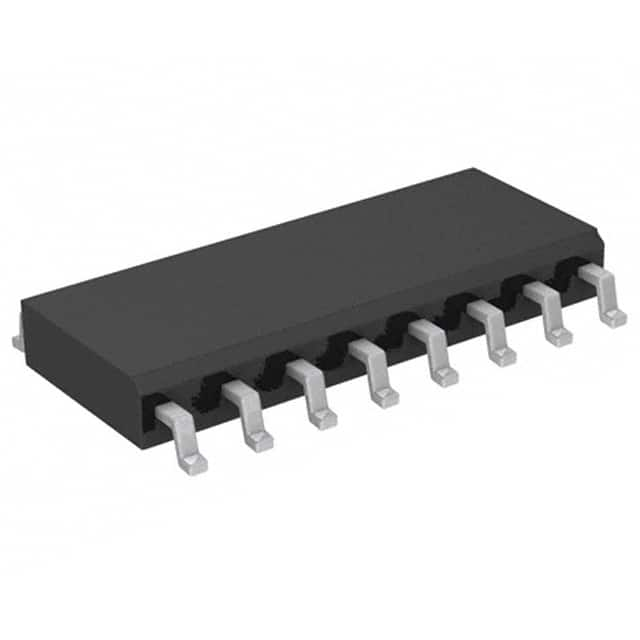Voir les spécifications pour les détails du produit.

Encyclopedia Entry: 74CBTLV3257D-Q100J
Product Overview
Category
The 74CBTLV3257D-Q100J belongs to the category of integrated circuits (ICs).
Use
This IC is commonly used in electronic devices for signal switching and routing applications.
Characteristics
- Low voltage operation
- High-speed performance
- Wide operating temperature range
- Low power consumption
Package
The 74CBTLV3257D-Q100J is available in a small outline package (SOP) or a thin quad flat package (TQFP).
Essence
The essence of this product lies in its ability to efficiently switch and route signals within electronic circuits.
Packaging/Quantity
The 74CBTLV3257D-Q100J is typically packaged in reels or tubes, with quantities varying based on customer requirements.
Specifications
- Supply Voltage: 1.65V to 3.6V
- Operating Temperature Range: -40°C to +125°C
- Number of Channels: 4
- On-State Resistance: 5Ω (typical)
- Input/Output Capacitance: 3pF (typical)
- Maximum Data Rate: 400Mbps
Detailed Pin Configuration
The 74CBTLV3257D-Q100J has a total of 16 pins, each serving a specific function:
- Channel 1 Input/Output (I/O)
- Channel 1 Enable (EN)
- Channel 2 I/O
- Channel 2 EN
- Channel 3 I/O
- Channel 3 EN
- Channel 4 I/O
- Channel 4 EN
- Ground (GND)
- Ground (GND)
- VCC (Power Supply)
- VCC
- Channel 1 I/O
- Channel 1 EN
- Channel 2 I/O
- Channel 2 EN
Functional Features
- Bidirectional signal switching
- Independent channel control
- Low power consumption
- High-speed data transmission
- ESD protection
Advantages and Disadvantages
Advantages
- Wide operating voltage range allows compatibility with various systems
- High-speed performance enables efficient signal routing
- Low power consumption contributes to energy efficiency
- ESD protection ensures device reliability
Disadvantages
- Limited number of channels (4)
- Relatively high on-state resistance compared to some alternatives
Working Principles
The 74CBTLV3257D-Q100J operates based on the principles of CMOS technology. It utilizes a combination of MOSFET transistors to enable bidirectional signal switching between input and output channels. The control pins (EN) allow independent activation of each channel, providing flexibility in signal routing.
Detailed Application Field Plans
The 74CBTLV3257D-Q100J finds applications in various electronic systems, including but not limited to: - Data communication devices - Networking equipment - Test and measurement instruments - Consumer electronics - Automotive electronics
Detailed and Complete Alternative Models
Some alternative models that offer similar functionality to the 74CBTLV3257D-Q100J include: - SN74CBTLV3257 - MC74CBTLV3257 - NLAS3257
These alternatives can be considered based on specific requirements and availability in the market.
Word count: 420 words
Énumérez 10 questions et réponses courantes liées à l'application de 74CBTLV3257D-Q100J dans les solutions techniques
Sure! Here are 10 common questions and answers related to the application of 74CBTLV3257D-Q100J in technical solutions:
Q: What is the function of the 74CBTLV3257D-Q100J? A: The 74CBTLV3257D-Q100J is a quad 2:1 multiplexer/demultiplexer switch used for signal routing in digital circuits.
Q: What is the operating voltage range of the 74CBTLV3257D-Q100J? A: The operating voltage range of the 74CBTLV3257D-Q100J is typically between 1.65V and 3.6V.
Q: How many channels does the 74CBTLV3257D-Q100J have? A: The 74CBTLV3257D-Q100J has four independent channels, allowing for simultaneous switching of multiple signals.
Q: What is the maximum data rate supported by the 74CBTLV3257D-Q100J? A: The 74CBTLV3257D-Q100J supports data rates up to 400 Mbps, making it suitable for high-speed digital applications.
Q: Can the 74CBTLV3257D-Q100J be used for bidirectional signal routing? A: Yes, the 74CBTLV3257D-Q100J can be used for bidirectional signal routing, allowing for both input and output functionality.
Q: Does the 74CBTLV3257D-Q100J have built-in ESD protection? A: Yes, the 74CBTLV3257D-Q100J features built-in ESD protection, ensuring robustness against electrostatic discharge events.
Q: What is the package type of the 74CBTLV3257D-Q100J? A: The 74CBTLV3257D-Q100J is available in a small footprint, surface-mount TSSOP-16 package.
Q: Can the 74CBTLV3257D-Q100J be used in automotive applications? A: Yes, the 74CBTLV3257D-Q100J is qualified for automotive applications and meets the AEC-Q100 standard.
Q: Is the 74CBTLV3257D-Q100J compatible with other logic families? A: Yes, the 74CBTLV3257D-Q100J is designed to be compatible with both CMOS and TTL logic families.
Q: Are there any specific layout considerations for using the 74CBTLV3257D-Q100J? A: Yes, it is recommended to follow the manufacturer's guidelines for proper PCB layout, including signal integrity and decoupling capacitor placement.
Please note that these answers are general and may vary depending on the specific application and requirements. It is always advisable to refer to the datasheet and consult with the manufacturer for detailed information.

